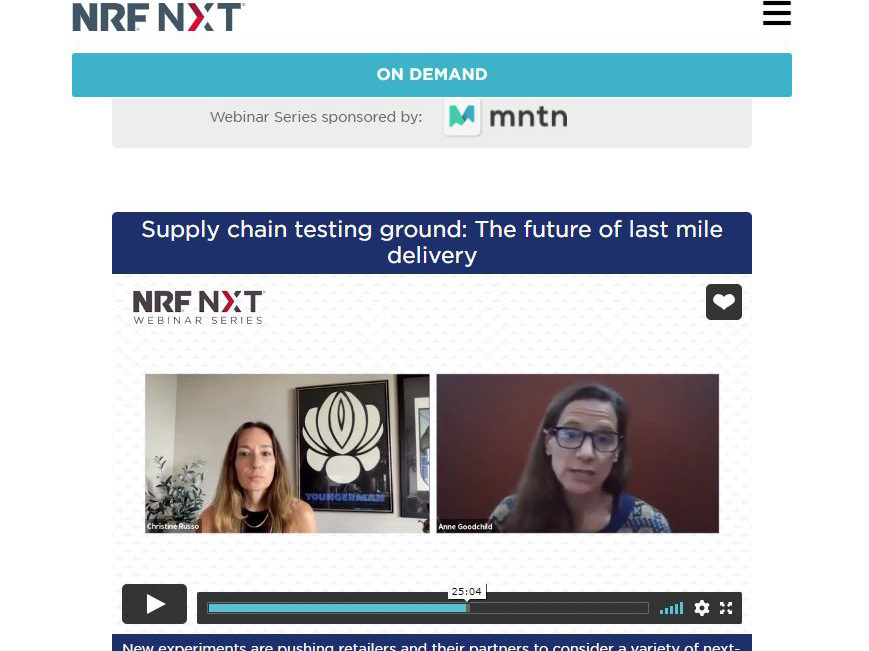
By Peter Johnston
The opening session in the free NRF NXT Webinar Series was devoted to last-mile delivery, one of the toughest challenges in retail today. Moderated by Christine Russo, founder of the Retail Creative and Consulting Agency, the session featured Nate Faust, founder of sustainable logistics company Olive, and Anne Goodchild of the University of Washington, professor and founding director of UW’s Supply Chain Transportation & Logistics Center, which launched the Urban Freight Lab in 2016.
The session began with a brief discussion of the COVID-19 pandemic and its impact on retail. Rather than creating a new problem, panelists agreed, the pandemic and the subsequent explosion in ecommerce simply exacerbated an already-present problem.
“Home delivery has been affecting transportation for close to thirty years,” Goodchild said. “COVID simply accelerated the growth that we had anticipated.”
It also, she noted, helped further a kind of broadening of focus. About 25 years ago, in research on urban freight systems, the emphasis was on heavy freight: oceangoing vessels, cross-continental rail and large trucks, with the goal of separating these activities from the places where people lived.
“COVID and ecommerce have really highlighted the freight that has to come to your neighborhood,” she said. “We’ve had it all along, of course — the post office, UPS, once upon a time the milkman — but now we’re bringing vehicles into people’s neighborhoods that they aren’t happy about.”
The final 50 feet
To address this unhappiness, Goodchild noted, it is necessary to understand what’s actually going on, and for a lot of different kinds of people with different agendas to sit down and talk about it.
Under her leadership, the Urban Freight Lab coined the term “final 50 feet” and defined it as the last leg of the supply chain for urban deliveries — finding a parking place, moving items from a delivery vehicle, navigating traffic, sidewalks, intersections, bike lanes and building security, and delivering them to the recipient.
Beyond its impact on customer satisfaction, the final 50 feet is expensive, accounting for an estimated 25 percent to 50 percent of total supply chain cost. It’s also the most time-consuming part of the delivery process.
To make the last 50 feet an easier journey, the UFL has been working to facilitate conversations among city planners, infrastructure builders and users, with the goal of achieving solutions that work for everybody. There is some institutional catchup that needs to take place, Goodchild said, along with improvements in organizational capacity and dedicated funding.
“It’s still a challenge for most cities or transportation planners. They don’t have good data on the movement of goods in their jurisdiction.”
On the hopeful side, she noted that the pandemic has convincingly demonstrated the need for people to change their minds about things in a hurry. “I’m really impressed when I go out and see restaurants and transportation companies, and how quickly they’ve had to adapt. It’s really brought out the entrepreneurial spirit: ‘Well, here we are. What are we going to do to get this stuff to where it’s going?’”
The driveway epiphany
The entrepreneurial spirit was solidly represented by Goodchild’s co-panelist, Nate Faust, co-founder of Olive. A serial entrepreneur and ecommerce veteran, Faust was an early employee and member of the management team of Diapers.com/Quidsi (sold to Amazon in 2010) and co-founder and COO of Jet.com (sold to Walmart in 2016), after which he became SVP of Walmart’s U.S. ecommerce supply chain.
Then, one day while he was taking out the trash — making his fourth trip down the driveway with armloads of ecommerce packaging — he looked at his neighbors’ driveways and realized that they too were piled high with cardboard boxes headed for a landfill.
“I had an epiphany,” he said. “After 25 years of ecommerce, this is the delivery experience: 10 billion shipments a year, all in single-use, one-way packaging.”
Thus was born Olive, which features reusable, returnable shipping containers and a once- or twice-a-week delivery schedule. (It also features pickup of containers, which greatly facilitates the returns process, helping endear the system to consumers.)
Launched about six months ago, Olive has affiliate merchandising relationships with about 100 fashion/apparel retailers, among them Adidas, Anthropologie, Diane von Furstenberg, Michael Kors, Saks Fifth Avenue and UGG Australia.
Facts of life
Faust understands that his pursuit of environmental goals has to be carefully shaped to the goals of Olive’s market. “In order to have the greatest long-term impact on long-term sustainability,” he said, “consumers will have to use the service because they love it, not because they feel like they should use it or have to make compromises to do so. We offer the regular delivery schedule and ease of return in place of speed, and 98 percent of consumers like the deal.”
Goodchild also dwells in reality. Asked about the possibility of new-gen delivery options like Honeywell’s urban air mobility, she said, “I’m kind of a pragmatist, so I think a lot about how much things cost, and how well we’re managing the system we already have. It’s very expensive to build infrastructure. It’s great to explore new possibilities, but there are a lot of very boring things like potholes and lane striping that we’re also going to have to spend a lot of money on.”